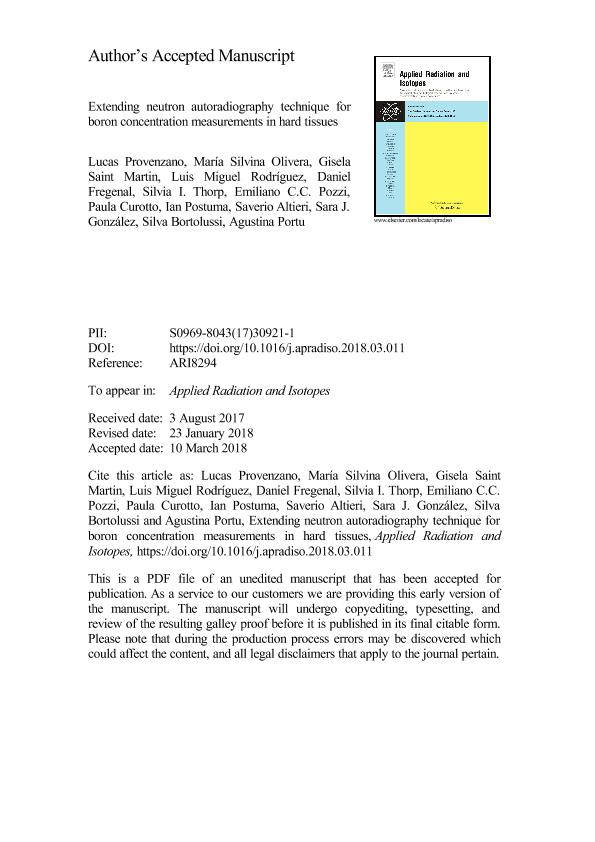Artículo
Extending neutron autoradiography technique for boron concentration measurements in hard tissues
Provenzano, Lucas ; Olivera, María Silvina; Saint Martin, María Laura Gisela; Rodriguez, Luis Miguel
; Olivera, María Silvina; Saint Martin, María Laura Gisela; Rodriguez, Luis Miguel ; Fregenal, Daniel Eduardo
; Fregenal, Daniel Eduardo ; Thorp, Silvia Inés; Pozzi, Emiliano César Cayetano; Curotto, Paula; Postuma, Ian; Altieri, Saverio; González, Sara Josefina
; Thorp, Silvia Inés; Pozzi, Emiliano César Cayetano; Curotto, Paula; Postuma, Ian; Altieri, Saverio; González, Sara Josefina ; Bortolussi, Silva; Portu, Agustina Mariana
; Bortolussi, Silva; Portu, Agustina Mariana
 ; Olivera, María Silvina; Saint Martin, María Laura Gisela; Rodriguez, Luis Miguel
; Olivera, María Silvina; Saint Martin, María Laura Gisela; Rodriguez, Luis Miguel ; Fregenal, Daniel Eduardo
; Fregenal, Daniel Eduardo ; Thorp, Silvia Inés; Pozzi, Emiliano César Cayetano; Curotto, Paula; Postuma, Ian; Altieri, Saverio; González, Sara Josefina
; Thorp, Silvia Inés; Pozzi, Emiliano César Cayetano; Curotto, Paula; Postuma, Ian; Altieri, Saverio; González, Sara Josefina ; Bortolussi, Silva; Portu, Agustina Mariana
; Bortolussi, Silva; Portu, Agustina Mariana
Fecha de publicación:
07/2018
Editorial:
Pergamon-Elsevier Science Ltd
Revista:
Applied Radiation and Isotopes
ISSN:
0969-8043
Idioma:
Inglés
Tipo de recurso:
Artículo publicado
Clasificación temática:
Resumen
The neutron autoradiography technique using polycarbonate nuclear track detectors (NTD) has been extended to quantify the boron concentration in hard tissues, an application of special interest in Boron Neutron Capture Therapy (BNCT). Chemical and mechanical processing methods to prepare thin tissue sections as required by this technique have been explored. Four different decalcification methods governed by slow and fast kinetics were tested in boron-loaded bones. Due to the significant loss of the boron content, this technique was discarded. On the contrary, mechanical manipulation to obtain bone powder and tissue sections of tens of microns thick proved reproducible and suitable, ensuring a proper conservation of the boron content in the samples. A calibration curve that relates the 10B concentration of a bone sample and the track density in a Lexan NTD is presented. Bone powder embedded in boric acid solution with known boron concentrations between 0 and 100 ppm was used as a standard material. The samples, contained in slim Lexan cases, were exposed to a neutron fluence of 1012 cm−2 at the thermal column central facility of the RA-3 reactor (Argentina). The revealed tracks in the NTD were counted with an image processing software. The effect of track overlapping was studied and corresponding corrections were implemented in the presented calibration curve. Stochastic simulations of the track densities produced by the products of the 10B thermal neutron capture reaction for different boron concentrations in bone were performed and compared with the experimental results. The remarkable agreement between the two curves suggested the suitability of the obtained experimental calibration curve. This neutron autoradiography technique was finally applied to determine the boron concentration in pulverized and compact bone samples coming from a sheep experimental model. The obtained results for both type of samples agreed with boron measurements carried out by ICP-OES within experimental uncertainties. The fact that the histological structure of bone sections remains preserved allows for future boron microdistribution analysis.
Palabras clave:
BNCT
,
BONE
,
NEUTRON AUTORADIOGRAPHY
Archivos asociados
Licencia
Identificadores
Colecciones
Articulos(CCT - PATAGONIA NORTE)
Articulos de CTRO.CIENTIFICO TECNOL.CONICET - PATAGONIA NORTE
Articulos de CTRO.CIENTIFICO TECNOL.CONICET - PATAGONIA NORTE
Articulos(SEDE CENTRAL)
Articulos de SEDE CENTRAL
Articulos de SEDE CENTRAL
Citación
Provenzano, Lucas; Olivera, María Silvina; Saint Martin, María Laura Gisela; Rodriguez, Luis Miguel; Fregenal, Daniel Eduardo; et al.; Extending neutron autoradiography technique for boron concentration measurements in hard tissues; Pergamon-Elsevier Science Ltd; Applied Radiation and Isotopes; 137; 7-2018; 62-67
Compartir
Altmétricas



